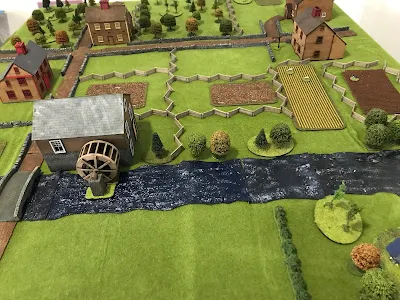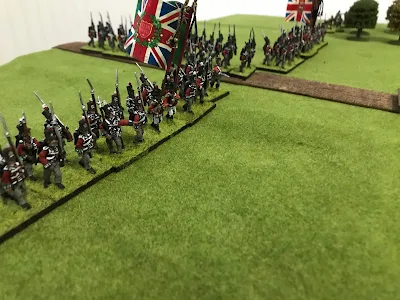This game will be based on the historical Battle of Cook's Mill in September 1814. A reinforced American Brigade was sent to destroy British/Canadian supplies in one of the final actions of the war along the Niagara. In this version the Americans must cross as the river and destroy the enemies supplies located in the town of Cook's Mill. The Canadian/British force will try and prevent that from happening. I have altered the historical order of battle slightly to better fit my present collection of figures. In addition I have added possible reinforcements to create a more interesting game.
All figures are 25mm and rules used are my version of the Fife and Drum miniature Rev War rules changed for the War if 1812.
Order of Battle:
American Order of Battle:
1st Brigade: Brig. Gen. Scott
1st Rifle Regiment (24)
9th US Regiment (24)
11th US Regiment (24)
22nd US Regiment (24)
25th US Regiment (24)
(All regiments are rated as regulars. The Rifle Regiment starts the game deployed by the cross roads West of the bridge. The remaining regiments enter the game one regiment each move on the east road. )
Possible reinforcements:
3rd Brigade: Brig.Gen. Porter
9th Pennsylvania Volunteers (24)
1st New York Volunteers (24)
2nd New York Volunteers (24)
Canadian Volunteers (24)
(at start of game roll 2d6 for turn they enter the game.)
In order to destroy supplies located in a building move a unit next to that building. You must roll a seven or better on 2d6 to destroy the supplies. The unit attempting it cannot be in close combat or fired at that turn.
British/Canadian Order of Battle:
2nd (Light Brigade): Lt. Col. Parsons
Battalion of Incorporated Militia of Upper Canada (24)
Glengarry Light Infantry (24)
1st Militia Brigade (24)
2nd Militia Brigade (24)
Mohawk Warriors (12)
Royal Artillery (medium gun)
Royal Marine Artillery (rocket)
(This force deploys on the table top at the North West corner.)
Reinforcements:
3rd Brigade Lt.Col. Morrison
1st Regiment
89th Regiment
100th Regiment
Flank Companies (Light Infantry and Grenadier)
(at start of game roll 2d6 for turn they enter the game.)
























































